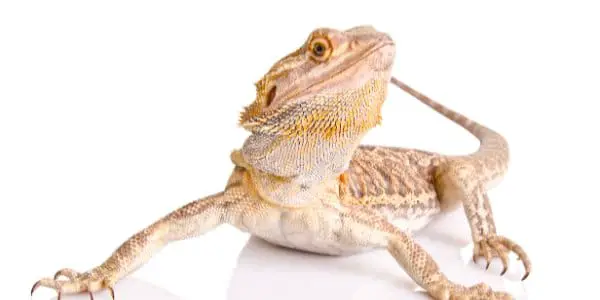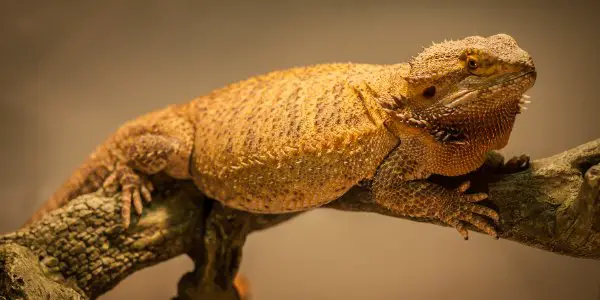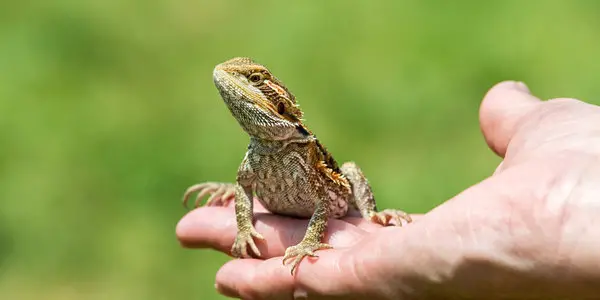Is your beardie struggling to move, or has it changed its walking style? Well, this can be a warning sign that there is an underlying problem that needs your immediate attention.
This guide discusses why a bearded dragon can’t move its legs or walk.
Common Causes of Bearded Dragon Leg Problems
If your bearded dragon experiences issues with its legs, majorly, it’s due to metabolic bone diseases, paralysis from impaction, broken bones, or other factors that we discuss below.
1. Metabolic bone disease
Metabolic bone disease (MBD) is caused by a lack of calcium or vitamin D3 in the body. Lack of calcium or vitamin D3 can be caused by improper lighting, malnutrition, liver disease, or eating an improper diet.
When reptiles lack calcium in their diet, they start eating their bones for calcium. If this goes on for some time, it may develop paralysis.
If your bearded dragon is showing signs of calcium deficiency, the chances are that it’s not getting enough calcium in its meals, its body is unable to absorb calcium, or they’re consuming food with an imbalanced phosphorous to calcium ratio. The phosphorous to calcium ratio for bearded dragons should be at least 1:2.
A bearded dragon’s body requires calcium to process phosphorous, which means it’ll struggle to absorb calcium if phosphorous levels are too high.
How Do You Know Your Bearded Dragon Has Calcium Deficiency?
If your beardie experiences mild calcium deficiency, they start getting weak front or back legs. This is mainly because their bodies begin to leach calcium from the bones. You need to review the lighting in their habitat and consider supplementation.
Another symptom of MBD is a swollen belly. Low levels of calcium affect muscle functioning, and this affects digestion. As a result, your bearded dragon may experience bloating and constipation, causing its belly to swell.
Other symptoms include:
- Soft facial bones and jaws
- Tail and back kinking
- Swollen limbs
- Tremors
- Twitching
- Paralysis
- Loss of appetite
- Hard knobs on long bones
- Fracture
- Lethargy
During the preliminary stages of MBD, your bearded dragon will look like it’s struggling to walk and might start trembling.
As the condition worsens, the muscles around the bones will wear out because of supporting the already compromised bones. The tissues become inflamed and develop some weakness.
In extreme cases, you’ll notice your beardie legs are wobbly, and the lizard might start walking on its wrists. If the ailment stays without treatment, it can lead to total paralysis, making your beardie incapable of walking.
The disease may paralyze the hind legs to the extent that the beardie walks while dragging them around.
How to Address Metabolic Bone Disease
· Review Your Bearded Dragon Diet
One of the leading causes of calcium deficiency and MBD in beardies is poor nutrition. Lizards, especially baby and juvenile dragons, need more calcium for growth and development.
Pet owners should ensure that their lizards savor foods rich in calcium. These include fruits and leafy greens.
Supplements are also crucial for captive-bred bearded dragons. To ensure that your bearded dragon has enough calcium in its reserves, you should always dust its food with calcium powder.
More importantly, vitamin D supplements will ensure that the bearded dragon’s body won’t have a problem with calcium absorption.

· Fix the Lighting and Heating in the Bearded Dragon’s Cage
UVB light plays a pivotal role in the bearded dragon’s life as it supplies vitamin D3, which facilitates calcium absorption. Therefore, even if you ensure that a bearded dragon consumes enough calcium but fail to correct its cage’s lighting, it will still suffer from calcium deficiency.
To ascertain that all the calcium consumed by bearded dragons is absorbed into the bloodstream, you need the correct type of UVB lamps in their enclosure. Tube UVB lights with an output of 10.0 to 12.0 are preferred since they cover a significant part of the tank.
If you use the wrong UVB lighting in your bearded dragon enclosure, the lizard will start using the calcium in its bone leading to Metabolic Bone Disease. This condition will affect your bearded dragon legs and impair their walking capability.
· Visit a Reptile Vet
When you spot any signs of MBD, contact your local reptile vet and schedule an appointment. The specialist will do various tests and make some recommendations. If the disease is in its early stages, changing its diet and fixing the lighting may help your bearded dragon recover.
However, vitamin injections and other medications might be used if your beardie has stayed with MBD for a considerable amount of time. Still, you must remember that the damages that occur for an extended period are irreversible and might even lead to death.
2. Impaction or Constipation
Impaction is when a beardie is not able to pass bowel movements. The condition can be fatal, especially if it lasts several days. Therefore, make sure to seek vet services as soon as possible.
Causes of Impaction
Several things may cause impaction in bearded dragons. These includes:
- Feeding your beardie a diet that lacks essential minerals and vitamins may cause impaction as the beardie may struggle to digest its food
- In addition, feeding your beardie foods high in sugars or fats but low in fiber cause impaction. Fiber, as is the case with humans, help in digestion.
- If you feed your pet food pieces that are too large to digest, they may experience impaction. Insects that are too large or those with hard shells can cause impaction. Therefore, when feeding your beardie, never give them insects that are larger than the space between their eyes.
- Overfeeding can also cause constipation or impaction as you’re not giving your dragon time to digest its food. A mass of food may form in its belly, thereby contributing to constipation
- A beardie in a tank with inadequate temperature regulation or improper UVB lighting may experience difficulty performing bodily functions such as digestion. Bearded dragons are cold-blooded and thus rely on their external environment to regulate their body temperature. That’s why you must ensure their enclosure has the correct temperatures in its tank and basking spot.
Symptoms and Remedies
Here are a few signs that may indicate your beardie is experiencing impaction:
- Having irregular bowel movements
- Extreme exhaustion and discomfort while walking
- Inability to move its hind legs
Some of the remedies for impaction include:
- Giving your pet a warm bath
- Changing its diet. You can feed your dragon softer foods to prevent worsening the problem
- Gently massaging your dragon from head to tail
If the problem persists, take your pet to the veterinary as fast as possible. Impaction is a serious condition that can lead to death if not treated
3. Overfeeding
Overfeeding can also make your dragon immobile as it can block its digestive tract, leading to impaction. Feeding your pet too much food or too often may lead to drastic weight gain, lethargy, and bloating. All these can interfere with its ability to move.
To prevent overfeeding, follow a three-day feeding cycle: feed your adult beardie salad on day one, insects on day two, and nothing on the third day. Such a feeding schedule will give your ample pet time to digest its food and prevent obesity. To avoid feeding your beardie too much protein, give it one 4-inch insect per meal.
If your pet overfeeds to an extent they become immobile, consult a vet specializing in bearded dragons.

4. Neurological Issues
Bearded dragons may also have difficulties walking if they suffer from neurological issues. Neurological problems manifest when you start seeing your bearded dragon walking in circles, hitting objects, or roaming.
Neurological conditions such as pinched nerves or head and spine injuries can affect the bearded dragon’s legs compromising its normal movement.
Since these issues are related to how the brain works, you’ll also notice other symptoms such as loss of balance, walking backward, and random tilting of the head. If you suspect your beardie has some neurological issues, you should rush them to the vet as delays can cause more damage.
When you visit the vet, they might recommend supportive care and might prescribe anti-inflammatory drugs to help relieve the distress. If your bearded dragon starts twitching or having seizures, you need to consider getting an MRI to inspect the extent of the damage.
Neurological issues may be caused by viral pathogens, infection, or trauma. However, note that some beardies might display signs such as partial blindness, tilting, staggering, and circling when they emerge from hibernation. However, they tend to improve after a month or so.
Therefore, while neurological issues might cause walking difficulties, you should also be aware that eye problems might cause your bearded dragon to behave in a certain way. Conversely, you might notice walking problems when bearded dragons come out of hibernation.
5. Dystocia
Dystocia is a problem where a female has mature eggs in her reproductive system but cannot pass them out. Although this condition is not common in beardie, it can happen to your pet.
A female dragon with mature eggs in its reproductive tract may lose its ability to move due to the excessive pressure on its spinal discs.
The only treatment for this condition is to take it to a vet for surgery.
6. Ear Infection
Inner ear infections can make your bearded dragon lose balance and start walking haphazardly. Like humans, bearded dragons rely on their inner ear for orientation, balance, and head positioning. Therefore the inner ear’s infections will compromise the bearded dragon’s balance, leading to awkward movements.
If your bearded dragon can lift its legs to walk but can’t keep balance when moving around, this might be a sign of an ear infection. However, you’ll need to visit a reptile vet for a comprehensive examination and reliable diagnosis.
7. Broken Bones
Your bearded dragon may have difficulties walking if it has broken its bones. If a beardie has broken a bone in one of its legs, it might start limping or have trouble walking. Lizards may be docile and calm, but they are also adventurous, and you will sometimes catch them climbing up and down.
Sometimes the exercises and adventures end with the bearded dragon falling and breaking bones, especially on its legs. Although it’s not typical for beardies to suffer bone fractures, they can fall and sustain leg injuries that make walking challenging.
One of the reasons bearded dragons may break legs easily is if they have MBD. This condition makes bones soft and fragile, breaking with the slightest force or pressure. Care should be taken when handling beardies to ensure they don’t fall and end up with broken bones.
If you suspect that your bearded dragon has some broken bones, we recommend you visit the nearest reptile vet.
They will conduct various tests and even some X-rays to determine the severity of the injury. The tests will also help the vet determine whether the injury was accidental or if the lizard suffers from MBD and has soft and fragile bones.

8. Overheating
Being cold-blooded animals, bearded dragons rely on external heat to regulate their internal temperature. When the terrarium is too hot, the lizard won’t function normally. Extreme temperature causes the bearded dragon to overheat and experience some bizarre symptoms.
Overheating causes dehydration, loss of balance, dizziness, organ failure, and even loss of consciousness. When this happens, the bearded dragon becomes incapacitated, and its legs become wobbly. If you expose your beardies to extreme temperatures, they will start getting dizzy and confused, and their movement will be compromised.
To be safe, you should maintain a temperature range of 95-105 degrees Fahrenheit in the basking area and 75-85 degrees Fahrenheit in the cool spot. When a terrarium is too hot, beardies will display signs like hiding, digging, glass surfing, and severe gapping.
Installing a thermostat and digital thermometers will help you maintain the bearded dragon’s tank temperatures at optimal levels.
9. Gout
Bearded dragons can suffer from gout if they have high amounts of uric in their blood. Unlike humans that excrete urea from their urinary systems, beardies release uric acid in the form of urate.
However, when the lizards stay without hydrating for a long time, their kidneys don’t filter out uric acid correctly, resulting in too much uric acid in the blood.
While gout can be caused by consuming too much protein and overdosing on medication, it is also attributed to old age. When there’s excess uric acid in the blood, it can lead to what is known as organ mineralization.
The uric acid waste crystals in the blood can cause the compression of sciatic nerves that run through the spinal cord to the hind limbs. When these nerves are compressed, they make it impossible for the brain to send commands to the back legs. If not addressed, it can lead to total paralysis of the hind legs.
10. Toxins
Bearded dragons are the most highly sensitive to chemicals. Toxins can cause total mental breakdown and even death when they enter the body.
Exposing your bearded dragons to toxins such as paints, sprays, insecticides, pesticides, and other chemicals can have dire consequences.
Toxicity in bearded dragons manifests in dizziness, confusion, and loss of consciousness. When experiencing these symptoms, it will be difficult for bearded dragons to walk normally.
Bearded dragon owners should take various precautions to avoid exposing their bearded dragons to toxins.
First, they should get the beardie out of the cage when cleaning it. Additionally, they should ensure that insecticides and paints have dried off and escaped out of the cage before putting the lizard back.
More importantly, you should consult your vet if you detect any sign of toxicity in your scaly friend.

Frequently Asked Question about Bearded Dragon Leg Problems
Why Is My Bearded Dragon Not Using the Back Legs?
If your beardie is dragging its hind legs and tail, you should take it to a vet as fast as possible to have it checked. Lower-body paralysis is a common side effect of impaction. In most cases, your bearded dragon will have shown other signs before suffering from lower body paralysis.
Impaction is when an animal cannot digest food for several reasons, including overfeeding, improper levels of vitamin D and calcium, metabolic bone disease, dystocia, or lack of essential minerals and vitamins.
You should be on the lookout for early signs of impaction, metabolic bone disease, or any change in walking style and take measures as fast as possible.
Can a Bearded Dragon Break Its Leg?
Although bearded dragons are hardy creatures, they can still break their limbs. This can happen from:
- Falling from heights. If you let them loose, bearded dragons can climb too high and fall, leading to limb injuries. Also, you can accidentally drop it, potentially causing front or hind legs to break.
- Metabolic bone disease. MBD is common in bearded dragons and occurs when they experience calcium deficiency.
- Bite from another beardie. If your bearded dragon shares a space with another dragon, they may engage in territorial wars. This can result in leg injuries. A dragon’s jaws can break another’s leg, especially if it’s younger and smaller. If you have to house dragons together, keep those that are close in age and size to prevent severe injuries during fights. Older dragons become overly aggressive when a younger dragon is brought to its habitat.
If a bearded dragon suffers from broken legs, you must seek vet services as quickly as possible.
Can Bearded Dragon Legs Heal Once They’re Broken?
A bearded dragon with broken legs can recover, especially if they are still young or the fracture is not severe. The fracture will heal with enough nutritional and structural support. However, it’s best to have an X-ray taken to ensure the bone has a high chance of healing.
If the broken bone results from metabolic bone disease, chances of recovery may be slim. MBD causes beardie’s legs to weaken due to the fragility of the bones. That’s why it’s crucial to ensure your bearded dragon gets enough UVB light, calcium, and vitamin D3.
How Do You Know a Bearded Dragon Leg Is Injured or Broken?
The only sure way to know your beardie’s limbs are broken or injured is to do an X-ray. Nevertheless, some signs can indicate your beardie has a leg problem:
- Not moving at all
- Dragging hind limbs
- Swelling around a limb
- Hardening of a limb
If you notice any of these signs, confine your dragon in an area that’s not moving too much until you get a vet for an X-ray and treatment.
Can a Bearded Dragon Injure Its Toe?
Yes, it’s common for beardies to suffer from a broken toe. Therefore, you shouldn’t fret if you see one of its toes unable to flex or turn black.
If a dragon experience a fractured toe, it’ll start turning black as the body prepares to release it. In most cases, your beardie will shed its injured toe and regenerate another without experiencing bleeding.
A dragon’s toe can break if it falls from a high tank perch and fails to land correctly. Metabolic bone disease can also cause bones to become weaker and thus increase the chances of toe fractures.
Can Bearded Dragon Legs Grow Back?
Unfortunately, if a dragon has lost its leg from breakage, the leg will not grow back. Some reptiles, such as geckos, can grow back their tails and limbs, but bearded dragons cannot grow back their tails.
However, most beardies will adapt to using the remaining legs after such a loss.
Why Are Bearded Dragon Front Legs Not Working?
We’ve talked a lot about bearded dragon hind legs not moving, but what if your beardie can’t move its front legs – what’s usually the issue?
In most cases, your dragon will lose power in its front legs mainly due to injuries and metabolic bone disease. Check its front legs to see if there’re injuries. If there’re no injuries, review lighting in its habitat and supplement with calcium and vitamin D3.
What Leg Problems Do Bearded Dragons Have?
Healthy bearded dragons should be able to walk on all fours. They should not struggle to walk with either the front or hind legs. Bearded dragons may suffer from various leg problems, including paralysis, bow legs, inflammation of the legs, and even broken bones.
How Should a Healthy Bearded Dragon Walk?
In its pristine condition, a bearded dragon should use its front and hind equally when moving around. It shouldn’t limp, have trouble lifting one leg, or drag the front or hind legs when walking.
At times, bearded will lay with their legs stretched wide like they’re doing splits, but they retrieve them into the normal position when they start walking.
If the bearded dragon starts moving with its legs stretched out, walks in circles, or has difficulty lifting its legs, this indicates a serious problem.
There are a handful of reasons why your bearded dragon may experience leg problems. Check out the next section for things that may impede your bearded dragon’s natural movement.
Why Your Bearded Dragon May Have Walking Difficulties?
If your bearded dragon isn’t able to move normally, it might be suffering from various conditions. These include:
- Metabolic Bone Disease
- Broken Bones
- Neurological Problems
- Paralysis
- Inner Ear Infection
- Vitamin Overdose
- Gout
- Overheating
- Toxins
Should I Be Worried If My Bearded Dragon Starts Walking on Its Wrists?
You may have spotted your bearded dragon walking on its wrists and probably wondered why it was doing that, yet it had its legs intact. The fact is that your bearded dragon may be having some issues with its legs. So, you should be very concerned if your bearded dragon displays such behavior.
Your bearded dragon may be walking with its wrist because of two reasons. First, it might be due to metabolic bone disease, which makes bones weak and easily fractured. Secondly, it might have excess weight to the extent that its legs don’t have enough strength to carry it.
If your beardie has MBD, it means that it has a calcium deficiency. This means that you need to give it foods with more calcium and supplement its diet with calcium and vitamin D supplements. Conversely, you need to fix the light in its enclosure since it’s the sole source of vitamin D3.
For overweight beardies, you’ll need to cut down on the insects and include more veggies and leafy green in the diet. You should also reduce the feeding frequency and let it snack on delicacies with low sugar and fat content.

Key Takeaways
If your bearded dragon cannot move or moves weirdly, it can be a sign of an underlying problem such as impaction, metabolic bone disease, or neurological issues. Also, it can be because of overfeeding, too high temperatures in its habitat, or broken legs.
You can solve the issue of metabolic bone disease and overheating through supplementation and regulating temperatures. If the problem is due to impaction, neurological issues, or broken legs, you need to see your vet as soon as possible.